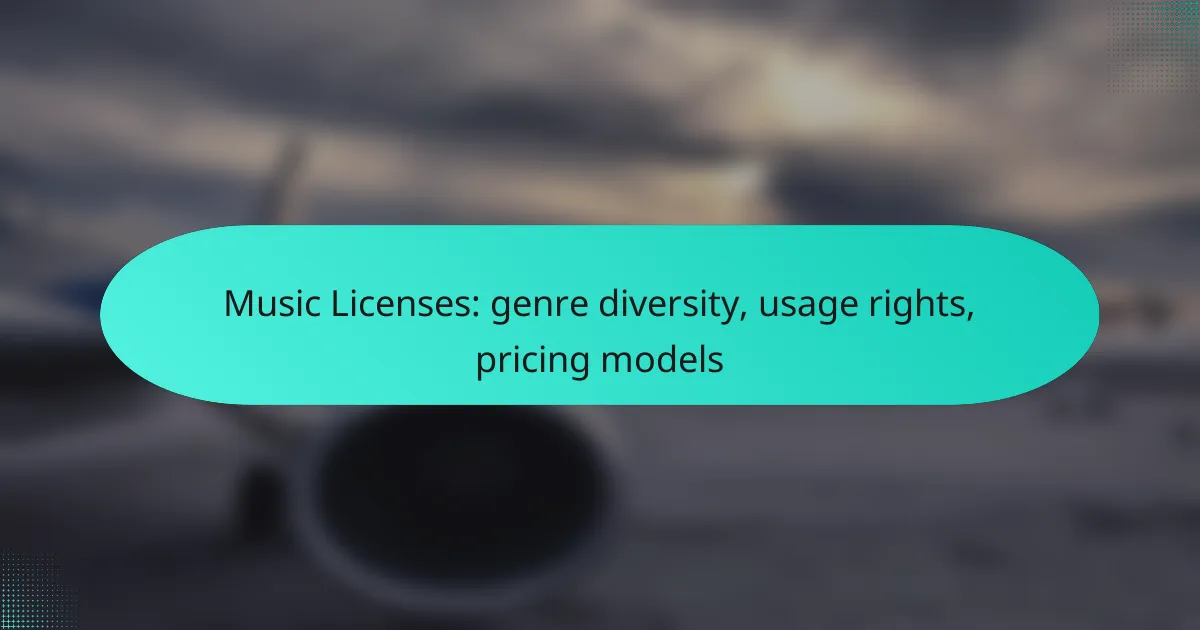Music licenses play a crucial role in the legal use of music across various contexts, including performance, reproduction, and synchronization with visual media. The diversity of music genres significantly influences the structure of these licenses, impacting usage rights and pricing models. Understanding the specific rights associated with each license is essential for anyone seeking to navigate the complexities of music usage legally.
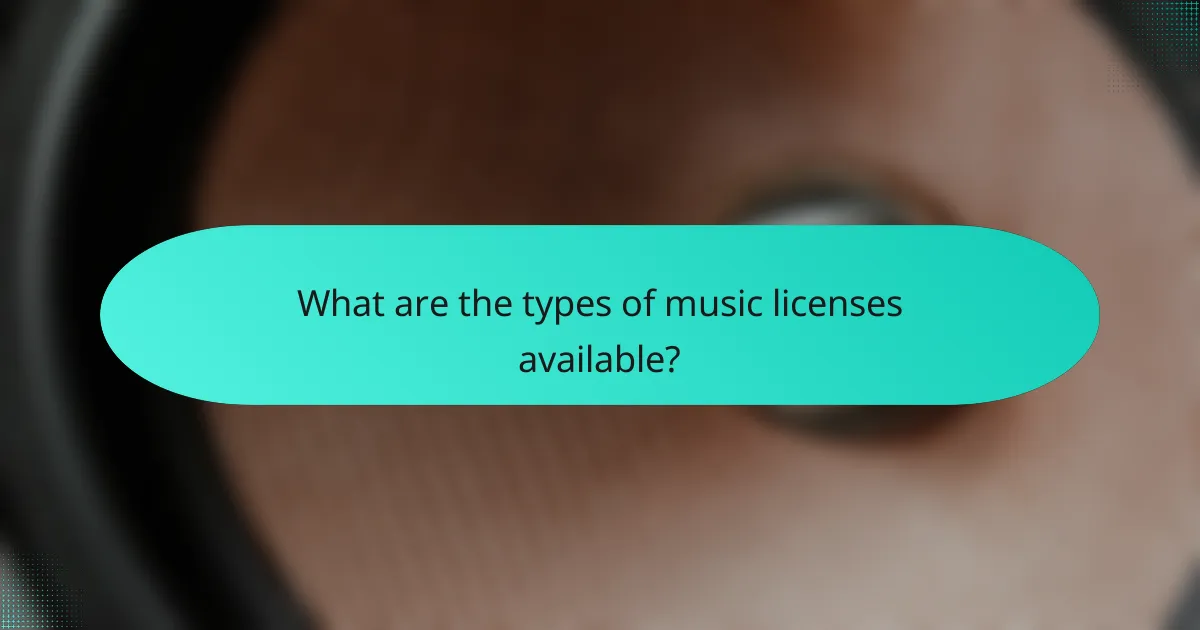
What are the types of music licenses available?
There are several types of music licenses that cater to different uses and rights. Understanding these licenses is essential for anyone looking to use music legally, whether for performance, reproduction, or synchronization with visual media.
Performance licenses
Performance licenses are required when music is played publicly, such as in concerts, restaurants, or radio broadcasts. These licenses ensure that songwriters and publishers receive royalties for their work. Organizations like ASCAP and BMI in the United States manage these licenses and charge fees based on factors like venue size and audience capacity.
Mechanical licenses
Mechanical licenses are necessary for the reproduction of music, typically when songs are recorded and distributed on physical formats like CDs or digital downloads. The license grants the right to reproduce the composition and usually involves paying a set fee per copy sold. In the U.S., the statutory rate for mechanical licenses is often around 9.1 cents per song per copy.
Synchronization licenses
Synchronization licenses are needed when music is used in conjunction with visual media, such as films, TV shows, or advertisements. These licenses allow the music to be “synchronized” with the visuals, and fees can vary widely based on the project’s budget and the song’s popularity. It’s crucial to negotiate these licenses directly with the rights holders.
Master licenses
Master licenses grant permission to use a specific recording of a song, distinct from the composition itself. This type of license is often required when a specific version of a song is needed for a project, such as a film or commercial. Fees for master licenses can be substantial, depending on the recording’s fame and the intended use.
Public domain licenses
Public domain licenses apply to music that is no longer under copyright protection, allowing anyone to use the music without paying royalties. Works typically enter the public domain after a certain period, which varies by country. Users should verify the status of a piece to ensure it is indeed in the public domain before use.
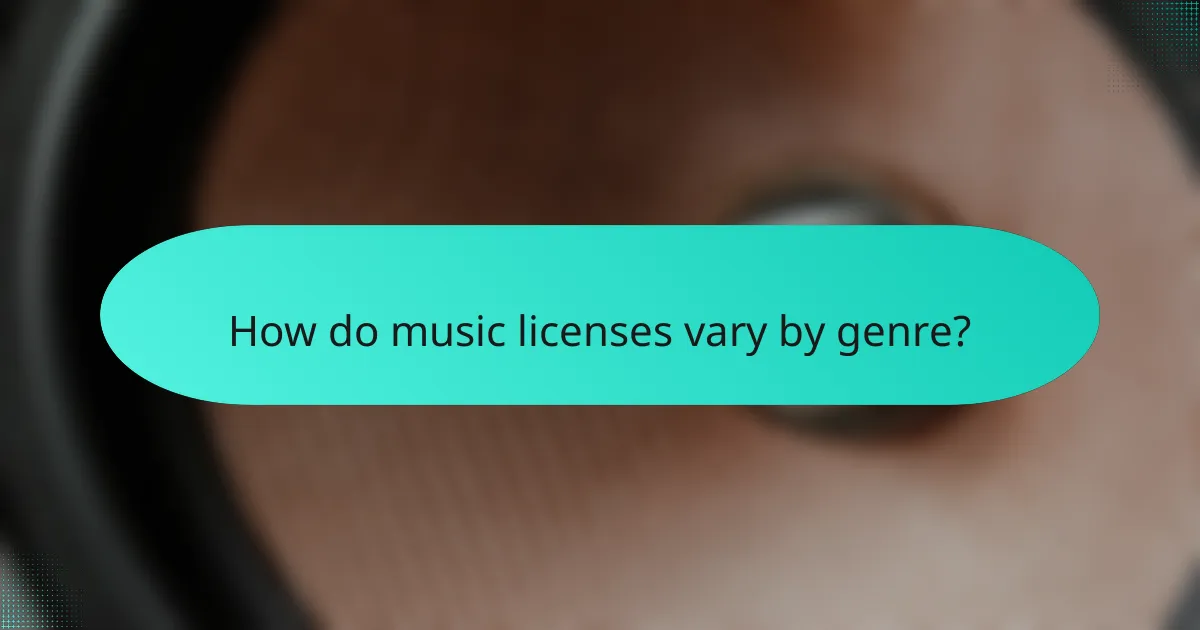
How do music licenses vary by genre?
Music licenses differ significantly by genre, affecting usage rights, pricing models, and the complexity of obtaining permissions. Each genre has its own characteristics that influence how licenses are structured and what rights are granted to users.
Licensing for pop music
Pop music licenses are often straightforward, as this genre is widely consumed and commercialized. Typically, licensing fees can range from a few hundred to several thousand dollars, depending on the song’s popularity and the intended use, such as for commercials or films.
When licensing pop music, consider the type of rights needed, such as synchronization rights for video use or mechanical rights for physical copies. Always ensure that you have the correct permissions to avoid legal issues.
Licensing for classical music
Classical music licensing can be more complex due to the age of many compositions and the varying rights held by different entities. While public domain works can be used freely, modern arrangements may require specific licenses, often costing between a few hundred to several thousand dollars.
When using classical music, check if the composition is in the public domain and whether the specific recording you wish to use is licensed. This can save costs and simplify the licensing process.
Licensing for electronic music
Electronic music licenses can vary widely based on the artist and the distribution method. Independent artists may offer more flexible licensing options, while established names might charge higher fees, often ranging from hundreds to thousands of dollars.
Consider the intended use when licensing electronic music, as some artists may allow for non-commercial use at lower rates. Always clarify the terms to ensure compliance with the artist’s requirements.
Licensing for hip-hop music
Hip-hop music licensing often involves multiple rights holders, including producers and featured artists, making it more intricate. Licensing fees can vary greatly, typically from a few hundred to tens of thousands of dollars, depending on the song’s fame and the usage context.
When licensing hip-hop tracks, be aware of sample clearances, as using samples without permission can lead to legal complications. Always negotiate terms with all rights holders to secure the necessary permissions for your project.
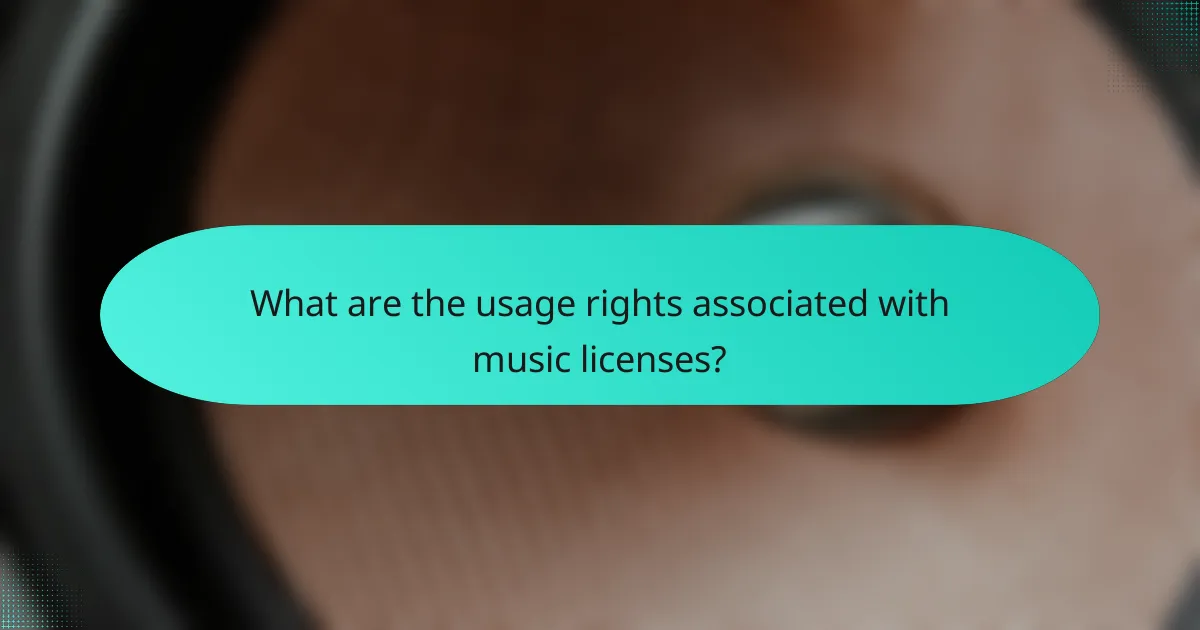
What are the usage rights associated with music licenses?
Usage rights in music licenses define how a piece of music can be used, including reproduction, distribution, public performance, and adaptation. Understanding these rights is crucial for anyone looking to use music legally in various contexts, such as commercial projects or personal use.
Reproduction rights
Reproduction rights allow the licensee to make copies of the music, whether in physical formats like CDs or digital formats such as downloads and streams. This right is essential for anyone producing music compilations or including tracks in multimedia projects.
When acquiring reproduction rights, it’s important to clarify the scope, such as the number of copies allowed and the formats permitted. Licensing fees can vary widely based on the artist’s popularity and the intended use, ranging from a few dollars for independent artists to thousands for well-known tracks.
Distribution rights
Distribution rights grant the licensee permission to distribute copies of the music to the public. This includes sharing music through platforms like Spotify, Apple Music, or physical distribution in stores. Without these rights, distributing music can lead to legal issues.
Consider the distribution channels when negotiating rights. Some licenses may cover specific platforms or formats, while others may be more general. Fees often depend on the expected reach and the artist’s market value, typically ranging from a flat fee to a percentage of sales.
Public performance rights
Public performance rights are necessary for playing music in public spaces, such as restaurants, clubs, or events. These rights ensure that artists are compensated when their music is performed outside of private settings.
Obtaining public performance rights usually involves licensing through organizations like ASCAP or BMI, which manage royalties for artists. Fees can vary based on the venue size and type of event, often calculated as a flat annual fee or a percentage of ticket sales.
Adaptation rights
Adaptation rights allow the licensee to modify or create derivative works based on the original music, such as remixes or mashups. This right is crucial for producers and artists looking to innovate while using existing tracks.
When seeking adaptation rights, it’s vital to specify the nature of the adaptations allowed. Licensing costs can vary significantly, often influenced by the intended use and the original artist’s reputation. Always ensure that adaptations respect the original creator’s rights and intentions.
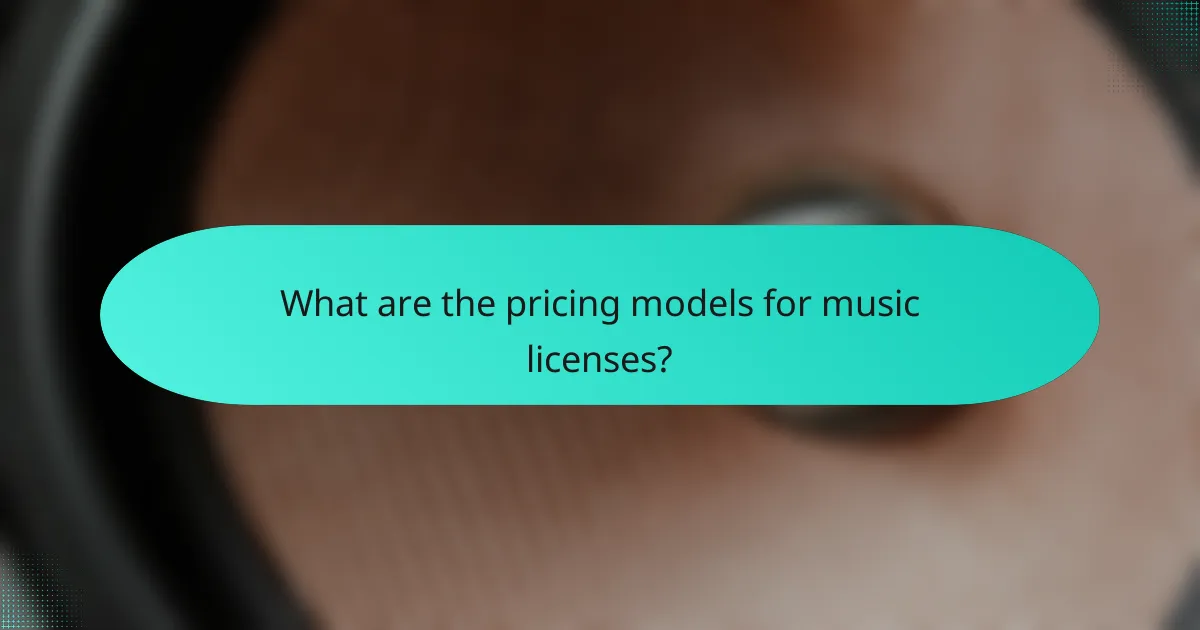
What are the pricing models for music licenses?
Music licenses typically operate under three main pricing models: flat fee, royalty-based, and subscription-based licensing. Each model offers different advantages and considerations depending on the intended use and budget.
Flat fee licensing
Flat fee licensing involves a one-time payment for the rights to use a piece of music. This model is straightforward, making it easy for businesses and creators to budget for their music needs without ongoing costs.
When considering flat fee licenses, it’s essential to check the terms, as they may vary by duration and usage type. For example, a flat fee might range from a few hundred to several thousand dollars, depending on the music’s popularity and the scope of use.
Royalty-based licensing
Royalty-based licensing requires payment based on the usage of the music, typically calculated as a percentage of revenue generated from the project. This model is common in industries like film and television, where the music’s impact on earnings can be significant.
It’s crucial to understand the royalty structure before committing, as rates can vary widely. For instance, royalties might range from a few percent to over ten percent of gross revenue, depending on the agreement and the artist’s stature.
Subscription-based licensing
Subscription-based licensing allows users to access a library of music for a recurring fee, often monthly or annually. This model is popular among content creators who need regular access to diverse music without the hassle of individual licenses.
When choosing a subscription service, consider the library’s size, the quality of music, and the specific rights included. Prices can vary, typically ranging from $10 to $50 per month, depending on the service and the extent of usage rights provided.
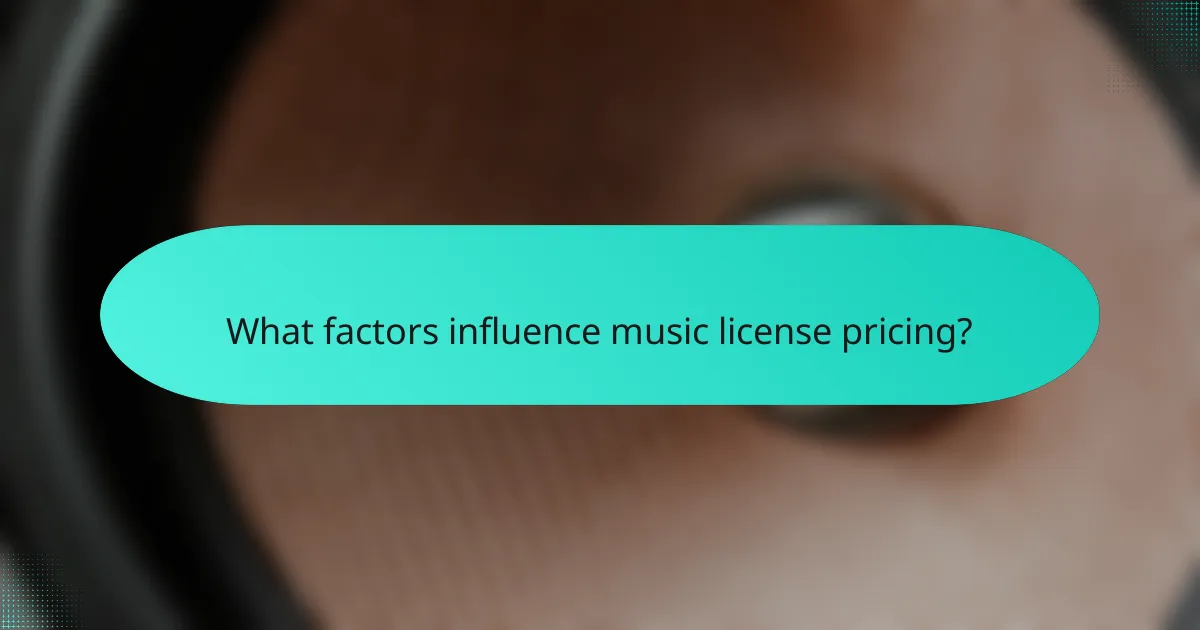
What factors influence music license pricing?
Music license pricing is influenced by several key factors, including the type of license, duration of use, and market demand. Understanding these elements can help you navigate costs and make informed decisions when acquiring music rights.
Type of license
The type of music license you choose significantly impacts pricing. For instance, a synchronization license, which allows music to be used in visual media, typically costs more than a mechanical license for reproducing music on physical media. Additionally, exclusive licenses, which grant sole rights to a piece of music, are generally more expensive than non-exclusive options.
Common license types include:
- Synchronization License
- Mechanical License
- Public Performance License
- Master Use License
Duration of use
The duration for which you intend to use the music also affects the licensing fee. Short-term licenses, such as those for a single event or project, usually cost less than long-term licenses that cover multiple uses over several years. For example, a one-time use in a promotional video may incur a lower fee compared to a yearly subscription for background music in a retail store.
When negotiating, consider how long you need the rights and whether a longer-term agreement might offer better value overall.
Market demand
Market demand plays a crucial role in determining music license pricing. Popular songs or tracks from well-known artists tend to have higher licensing fees due to their demand. Conversely, lesser-known or independent artists may offer more competitive pricing to attract users.
Monitoring trends and understanding the popularity of specific genres can help you anticipate pricing fluctuations. Engaging with music licensing platforms can also provide insights into current market rates and help you find cost-effective options.
